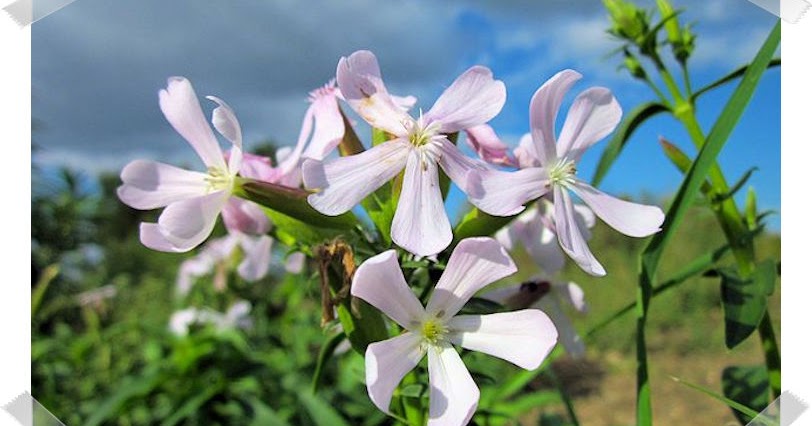Soapwort Flowers
When it comes to cleaning, some of us get into rather a lather over what can be used instead of chemical detergents to clean clothes and fabrics in the home. Nature and the world of herbs can help; there are a variety of herbs that have naturally occurring compounds that will generate a lather for cleaning. Soapwort with its Latin name of Saponaria officinalis is one of these herbs, which can be used as a mild detergent for fine fabrics or upholstery.
It is especially effective as a mild cleanser for old or antique fabrics, including rugs and tapestries and has been used to clean fabrics since the late middle-ages, the ancient Greeks and Romans are said to have used it for cleaning wool, although some believe soapworts use then was misidentified and the roots of Gypsophila (Gypsophila paniculata) better known to florists today as “Baby’s Breath” was the herb used.John Gerard in his 16th century herbal wrote that soapwort ‘is used in baths to beautifie and cleanse the skin’ whilst Nicolas Culpeper in his 17th century herbal remarked that soapwort ‘easily washes greasy spots out of clothes’. So gentle and effective is it, that soapwort root is still used today to clean old tapestries and textiles such as the Bayeaux Tapestry. It’s been used by the National Trust on delicate fabrics and textiles since the root was famously used to restore the curtains which dated back to 1746 that hung in Uppark House in Sussex by the then owner Lady Meade-Fetherstonhaugh. Seeing that the curtains needed some TLC, she consulted her friend, Hilda Leyel who was also a well-known herbalist and author of the time for advice. Hilda was founder of the Society of herbalists, later to become the Herb Society and did much for the rights of people to be able to consult a herbalist and have access to herbal medicine.Together Lady Meade-Fetherstonhaugh and Mrs Leyel investigated herbs that could be used to clean textiles and decided that soapwort best suited the job, so they used the leaves and roots of soapwort to make a natural cleaning solution. Lady Meade-Fetherstonhaugh was so impressed with the results of the soapwort cleaning solution that she remarked ‘It is a miracle process which not only cleans but heals the material by feeding and strengthening the threads of the textile’.
Lady Meade-Fetherstonhaugh believed that the soapwort worked best with spring water or what she called ‘living water’, I wonder if she knew that as a cleaning agent, soapwort works most efficiently if the water used is natural spring water or water with a pH of 5.7 or greater, or whether she just preferred to use natural spring water as she believed it to be purer than tap water? Whatever the reason, Lady Meade-Fetherstonhaugh became an expert restorer of fabrics and textiles, the curtains she restored were hanging in strips when she arrived at the house in the 1930’s, with stitching, and cleaning with her soapwort solution they were restored to look almost like new. She also used the soapwort solution to clean and restore bed hangings on the state bed at Uppark, and two chairs covered in the same cherry red brocade fabric were also restored, one with soapwort and one without, the difference in the restoration of the one treated with soapwort was said to be an ‘amazing contrast’. If you’d like to test out soapwort as a natural cleaner for yourself, here’s an easy recipe and method to try. Easy Soapwort Fabric Shampoo Ingredients25g Dried Soapwort Root1 Litre WaterNote: Always test on a small piece of fabric first or on an area that cannot be seen if the solution does not work. Consider using distilled or spring water if you live in hard water areas. Remember Lady Meade-Fetherstonhaugh believed spring water to be the best choice for the cleaning solution.
Method
Crush the roots with a rolling pin and leave to soak in the water overnight, this will allow the dried root to soften and make it easier for the saponins to be released. Place the soapwort and water in an enamel pan, bring to a boil, cover and simmer 20 minutes, stirring occasionally. Allow to stand until cool, then strain.
To use the soapwort shampoo on upholstery, lightly dampen a sponge or soft brush with the cooled solution, rub lightly and allow to dry, use a soft brush to bring back the ‘pile’ in the fabric. Apply again if necessary.
To use with fragile or delicate fabrics, allow the item to soak in cool water until thoroughly moistened, then soak in the cool Soapwort solution, then rinse again in cool fresh water.Soapwort is such a good natural cleaning agent because it is rich in mucilaginous saponins which aid the plant to produce a rich lather when agitated in warm water. As well as cleaning fabric and textiles, soapwort root can also be used as a shampoo to ease a dry itchy scalp, although try to avoid getting shampoo in the eyes as it can irritate them. To make a hair shampoo, boil the root for 20 minutes to release the saponins into the water, you can use a floral/herbal water or decoction as a base to improve the ‘earthy’ aroma that soapwort root gives off, or add a few drops of your favourite essential oil. Unlike man made shampoos, soapwort shampoo does not give a rich, creamy lather, it is mild and gentle, and leaves the hair feeling soft and smooth with no need for conditioner. Another benefit of using soapwort shampoo is it can help reduce the amount of hair that falls out of the head when brushing. NB: Before you try any alternatives to soap, especially if you’re using them to wash clothes, or as a shampoo make sure you do a skin test to check for possible allergic reaction to the herb.


